While a barbell may be one of the most sought-after pieces of gym equipment because of the wide variety of workouts it can accommodate, there is one big thing a barbell can’t do — clean itself. While not all barbells are the same, they do all require a little bit of TLC every now and then — a good cleaning once or twice a month should do the trick. To make sure your bar stays in good shape in your home gym for years to come, allow this article to be your barbell preservation guide.
You’ll need to remove the sleeves on multi-purpose barbells with bushings in order to properly clean them. That is not necessarily the case with powerlifting bars, but all barbells will need to have any dirt, lifting chalk, or dead skin removed from the knurling (the grip on the barbell). It’s important that this is done the right way though, so you don’t cause harm to the bar. No matter the coating of the bar, the cleaning process will remain the same. In this article, we’ll cover exactly how to clean and care for your barbell, and go over the supplies you’ll need to get started.
Things to Know About Barbell Cleaning and Car
- Over time, barbells will acquire rust, corrosion, and dead skin that needs to be removed. This cleaning process can be done across all types of barbell finishes, but stainless steel bars don’t need as much TLC when it comes to rust and corrosion.
- The knurling on a bar will attract debris over time. You’ll need to brush it out to keep the grip on your barbell feeling fresh.
- The loading sleeves need to be cleaned as well, as chalk, dirt, and dust can cause the spin rate to decrease, and the bearings or bushings to feel sticky.
How to Clean and Care for Your Barbell Video
Follow along as our reviews writer, Jake, shows you how to properly care for your barbell. He’ll walk you through the supplies you’ll need, all the steps in the process, and how best to store your barbell when you’re done.
Supplies Needed to Properly Clean Your Barbell
When it comes to cleaning your barbell, you don’t want to just blindly pick out some sanitary supplies — barbells do require specific care.
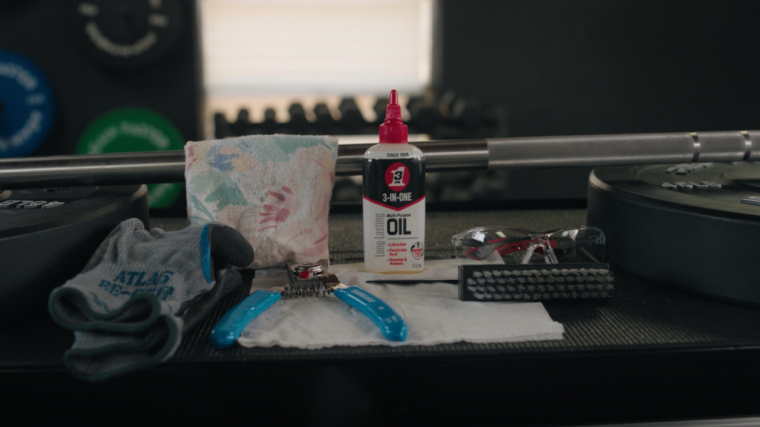
You’ll need lubricant, safety glasses, and gloves, among a few other products, but more on that below.
Safety Glasses
First and foremost, for your own safety, we recommend picking up a pair of safety glasses. This is to ensure that no loose debris comes in contact with your eyes while you are cleaning your barbell.
Three-In-One Lubricant
A three-in-one lubricant is necessary to remove built-up debris. Some people may advocate for WD-40, but there are reports that it may actually attract more dust into your loading sleeves. You want to avoid this, especially with a multi-purpose bar, so that you are able to get the controlled spin that’s necessary for certain lifts, like a power clean.
Snap Ring Pliers
You will also need to pick up some snap ring pliers. These help to properly remove and insert the snap rings that hold all of the washers within the loading sleeves of your barbell in place. We recommend dishing out some extra cash for a nice pair of pliers here. We tried to save a few bucks at first, but it wound up causing damage to our end cap.
Gloves
You will want to pick up a pair of gloves to clean your bar. This may not be necessary for some people, but they will keep excess oil off of your hands.
Rag
Since you will need to wipe off excess oil, as well as debris that has been built up on your bar, you will need a rag. If you don’t want to spend money on this, you can always use an old t-shirt if you want. We cut up an old pair of sheets for our barbell.
Nylon Brush
A nylon bristle brush is going to be the optimal choice to get build-up out of the knurling. We recommend nylon because there is a decreased chance of causing damage to the bar (a steel brush could be a bit too harsh).
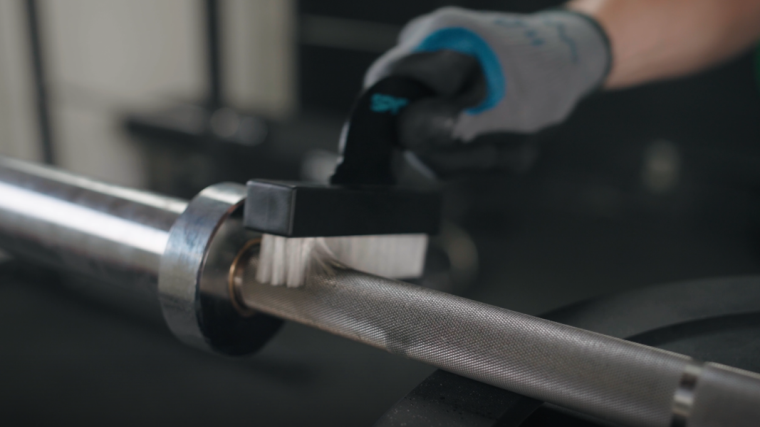
It’s also best to get a brush with relatively short bristles to allow more maneuverability to properly remove the debris from your knurling.
Where To Buy Your Supplies
You can get all of these supplies from your local hardware store or bike shop. It is worth mentioning that some companies, like Rogue for instance, do sell a full care kit that includes a nylon brush, and a bottle of three-in-one oil.
Price
Since a barbell can be very expensive and is an investment, you want to be sure to take care of it the proper way. A pair of safety glasses, gloves, and a nylon brush will cost you about $10 a piece. The three-in-one oil is around $4 for a four-ounce bottle, and a good pair of snap ring pliers could be anywhere from $30 to $40.
We recommend you don’t opt for cheap pliers — we had to make a second run to the store to get a better pair, so we could take the snap rings out of the loading sleeve properly. In total, you could be spending around $70 to $80, but these supplies are going to last you a long time and will help save you from having to buy an entirely new barbell sooner than you’d hoped (which would be far more expensive).
Some companies like Rogue Fitness do offer a barbell care kit for about $15. This is only going to include the oil and brush though, so you will still need to purchase everything else individually. Since you don’t need to have a fancy rag to wipe off the bar, we recommend just using something lying around your house to save some cash.
Loading Sleeve Anatomy
Cleaning the loading sleeves of a barbell is really only intended for multi-purpose bars that utilize bushings or bearings to allow you to perform Olympic and CrossFit-style lifts. Within the sleeves, you will find a set of snap rings and washers that hold the sleeves in place.
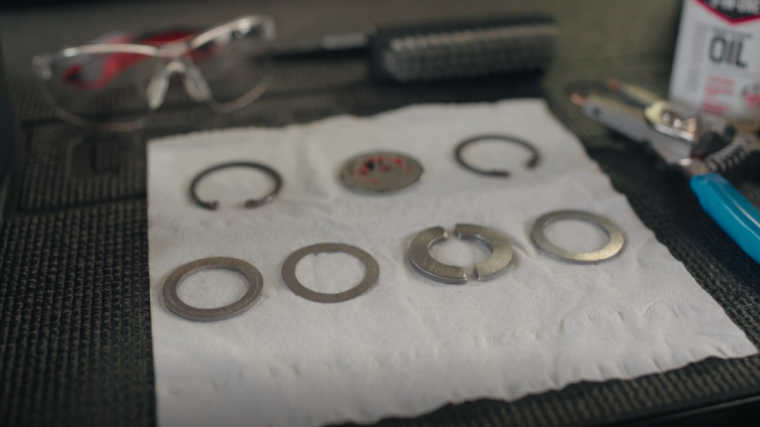
While not all sleeves are held together the exact same way, you will most likely find the order as follows: Outer Snap Ring, End Cap, Inner Snap Ring, Washer, Shim (if yours has one), a pair of Half Moon Washers, and another snap ring. Since they are all in a specific order, it’s imperative that you keep them in that order when removing the sleeves, so that you can properly put the sleeves back together.
How to Clean the Loading Sleeves of a Barbell
Once you have all of your supplies, start by taking the outer snap ring off. As you’re taking apart the sleeves, you may need a flat-head screwdriver or a similar tool that is thin enough to pry any of the washers loose if they are stuck. As we mentioned, it’s important to get a really good pair of pliers, or else you could damage the end cap. Since this process is very detailed, it may take you quite a while to get the hang of it — but eventually, you should be able to clean both loading sleeves in under 20 minutes.
Removing the Outer Snap Ring
Your first step when cleaning your loading sleeve is to remove the outer snap ring that holds your end cap into place. Since a lot of snap rings are painted chrome, it’s important to have a good pair of pliers that is going to create the right amount of tension to remove the ring. If you don’t have a solid pair, you may find yourself scratching the cap, and making it less aesthetic.
Both sets of snap rings have two small holes, insert the ends of your pliers into the two openings, and squeeze — this is going to compress the rings, and will allow you to remove them. An important thing to remember is that the snap rings are not identical. The outer snap ring is more rounded at the ends than the inner one.
Removing The Sleeves
Once the first snap ring is off, simply hit the end of the sleeve, and the end cap should fall out. When you remove the inner snap ring, you want to put your hand underneath the end of the sleeve, and push it away from you, that way if any of the hardware falls, you can catch it. This is where you will find the first washer, your possible shim (not every bar has one), your half-moon washers that fit into a groove, and then the last full washer.
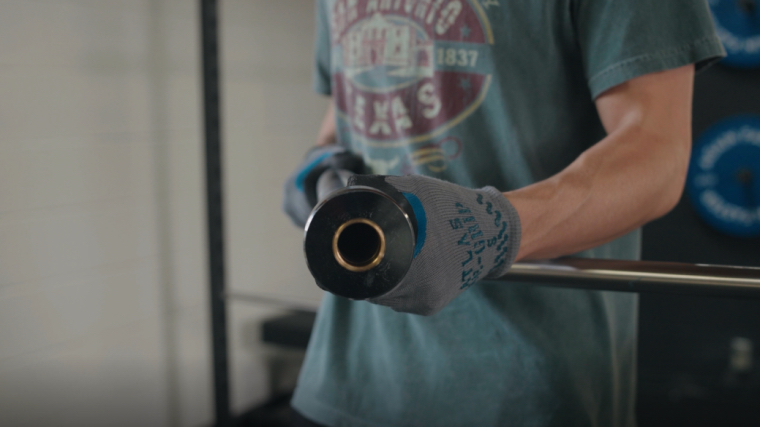
Once you finally have everything set aside, simply pull on the sleeve to remove it from the barbell. Grab your trusty rag, and wipe down the bushings or bearings within the sleeve while you have it in your hand. Then go ahead and wipe off any dirt, chalk, and the original lubricant that is on the end of the bar.
Lubricating The Sleeves
At this point, grab your three-in-one oil, and apply it to where the bushings, or bearings, come in contact with the bar. You don’t need to apply it in the middle, because the bar does not come in contact with the sleeves at that point. Place the sleeve back on the bar, and give it a spin to distribute the lubricant at those two points of contact.
Putting The Sleeves Back On
Now in reverse order, place all of the washers and snap rings back into place. So you will start with the last full washer you removed, then the half-moon washers, your shim if you have one, another full washer, the inner snap ring, end cap, and outer snap ring.
Once you place your half-moon washers into the groove, pull the sleeve in order to keep them locked in place. Keep moving down the line, and once you insert the inner snap ring, give it a good spin again to make sure the sleeve is spinning properly.

After you have put the end cap and outer snap ring back in place, you are good to go clean the other sleeve following the same steps. The snap rings can be a little tricky to put back in, you’ll want to insert the ends of your pliers into the openings, and give it a good squeeze like you did when you removed them, so they can snap back into place.
How to Clean the Knurling of a Barbell
In a much simpler process, you also need to clean the knurling of your barbell from any debris gathered during usage. Be sure to use a nylon brush so as not to scratch the knurling (scratches could end up attracting more dirt).
It’s best that you go ahead and do a dry brush down to remove any loose build-up you may have. After that, just apply a decent amount of the lubricant, and scrub your bar with the brush as needed. Once you’re satisfied with the way the bar looks, just wipe it down and you are good to go.
Properly Storing Your Barbell
Not only do you need to periodically clean your bar to keep it in good shape, but you also need to store it properly. While there are a couple of ways to store your bar, there are also a few ways you shouldn’t store your bar.
How Not To Store Your Barbell
The two worst ways to store your barbell are leaning it up against a wall, or with weight plates still loaded onto the sleeves. If you lean your bar against the wall, you are causing the sleeves to withstand unnecessary amounts of pressure, which can weaken the bar. And if you store your bar with your plates still loaded, you increase the chances of warping the bar over time, which you obviously don’t want.
The Correct Way To Store Your Barbell
If you have a power rack or a squat rack, you can always leave your bar on the j-hooks to keep it out of harm’s way. If you happen to have more than one barbell, you may want to invest in a storage rack — there are both vertical and horizontal racks that can mount onto your wall.
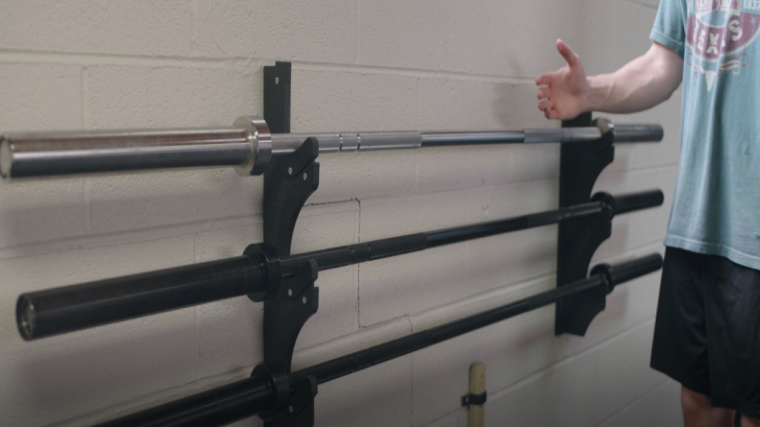
In our opinion, it’s best to store them horizontally on a power rack, squat rack, or mounted rack without any type of weight loaded onto it. This is going to evenly distribute the weight, and ensure that there isn’t any unnecessary pressure being placed on the weak points of the bar. If stored properly, you can keep your barbell in good shape for years to come.
Final Word
Since buying a barbell is an investment, it’s important to take the necessary care to keep your bar in usable shape. As you work out, there is going to be dead skin, dust, and possibly chalk that crowds the knurling and the loading sleeves. Cleaning the loading sleeves is a detailed process, but once you get the hang of it, you should have no problem doing it on the fly, and eventually, you should be able to get it done in under 20 minutes. However, the knurling is really easy to clean and only takes a few minutes.
Not only is it important to clean your barbell, but you also need to be sure to store it properly. This means storing it without any weight plates loaded onto the sleeves so that you don’t cause any damage to your bar, and potentially make it weaker. If you follow this process once or twice a month, your barbell should stay in great condition for many years to come.
FAQs
Where can I get supplies to clean my barbell, and how much will it cost?
You can grab everything you need at your local hardware store, or bike shop. Some fitness companies do offer care kits that include your lubricant and a brush for about $15. But otherwise, you can get all of the necessary products for around $70 to $80.
Is it bad to store a barbell with weight loaded onto the sleeves?
If you store your barbell with weight loaded onto it, you run the risk of warping the bar over time, and potentially making it weaker. It’s best to store it horizontally and without any weight on it to keep it in good shape.
Does the coating of a barbell impact how I need to clean it?
Regardless of your coating, you need to remove any debris that has built up over time to keep it in good condition. This process is not going to change — always use a nylon brush to prevent unnecessary scratches from forming on your barbell. While a stainless steel bar provides the most protection from rust and corrosion, you still need to clean it from time to time.